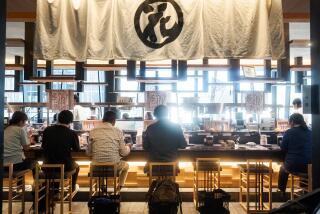Music and Dance Reviews : Koryu Kabuki Performs at Royce Hall
- Share via
In the last decade, Grand Kabuki tours of America became almost commonplace--with another due this summer. During the same period, smaller groups such as the Koryu Kabuki Dance Company helped heighten our appreciation of this classic, interdisciplinary Japanese theater idiom by concentrating on a central component: formal movement expression.
At Royce Hall, UCLA, over the weekend, Koryu Kabuki’s fine dancers and finer musicians presented dance-drama from the Grand Kabuki repertory as well as concert-dance in Kabuki style. The Saturday program proved rich in dance-mime: choreography rooted in realistic gesture.
Indeed, “Ayatsuri Sanbaso” provided a Japanese equivalent of the imitative doll-dancing familiar from such European ballets as “Coppelia,” “Petrushka” and “The Nutcracker.”
Worked by invisible strings, and eventually snarled in them, Seizaburo Saruwaka superbly suggested the weightless, drifting motion of a marionette, and the way he shook bells or flipped sleeves also looked exactly like a puppeteer’s clever manipulations.
In “Samidare,” Sumi Hanayagi created an artful character portrait from rainy-day behavior: holding and opening an umbrella, adjusting her clothes and hair, wearing or removing wooden clogs.
A depiction of rain also turned up in “Shigure Saigyo,” but this time abstracted to merely a delicately shimmering fan held overhead by Kichiyu Wakayagi. Otherwise this severely formal duet for Wakayagi and Setsuho Azuma proved spare in imagery, but powerful in the concentration of the dancers--and dominated by its intense score for a 12-member ensemble (chanters, samisen, flute and drums).
Befitting its ascetic theme, “Shigure Saigyo” largely banished the world from its movement vocabulary. In contrast, the trio “Genroku Furyu Odori” embraced the pleasures of that world with great vivacity, showing us samurai on the town with a young maiden--all dressed in incandescent colors.
Marked by a startling switch in character, costume and scenery, the solo “Oharame” depended even more on Mitsujiro Bando’s virtuosic ability to play both a jolly peasant woman and a forceful footman. The most obvious tour de force in an evening of consistent excellence.
More to Read
The biggest entertainment stories
Get our big stories about Hollywood, film, television, music, arts, culture and more right in your inbox as soon as they publish.
You may occasionally receive promotional content from the Los Angeles Times.










